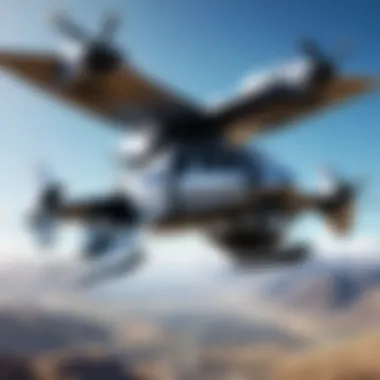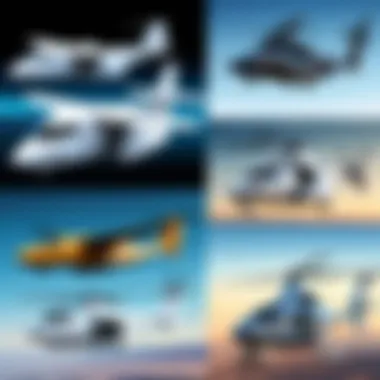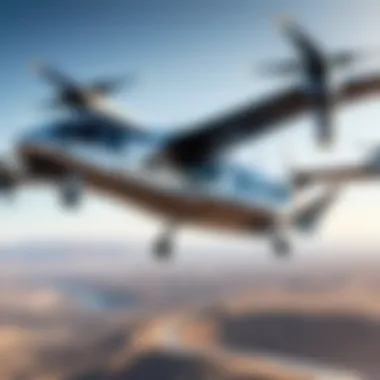Understanding Vertical Takeoff and Landing Technology


Intro
Vertical Takeoff and Landing (VTOL) technology represents a significant advancement in aviation. This technology allows aircraft to take off and land vertically, which can be remarkably useful in various contexts, especially in urban areas. As cities grow in population, the need for efficient transport solutions becomes ever more pressing. VTOL offers a potential answer to urban mobility challenges, combining flexibility and convenience.
This article explores the various facets of VTOL, including its operational principles, applications, and future prospects. It also highlights technological advancements and the challenges facing the VTOL sector, providing insights that remain vital for anyone interested in the ongoing evolution of aerospace technology.
Technology Insights
Latest Tech Trends
VTOL technology is experiencing rapid development, drawing interest from both established aerospace companies and new startups. One of the latest trends is the integration of electric propulsion systems. These systems reduce emissions and noise levels while improving efficiency. Notable examples include the Joby Aviation eVTOL and the Lilium Jet, both of which showcase the shift toward greener technologies.
Innovation in Tech
Innovation in VTOL extends beyond propulsion systems. Advanced materials are also being utilized to enhance performance and safety. Composite materials allow for lighter and more robust designs, contributing to improved fuel efficiency and operational costs. Additionally, autonomous flight systems are being incorporated. These systems promise to improve safety and reduce the need for skilled pilots, an important consideration as demand for VTOL services grows.
"The future of VTOL hinges on the ability of technology to meet both regulatory standards and customer expectations for safety and reliability."
Product Reviews
Reviewing specific VTOL aircraft can provide valuable insights into their capabilities. For instance, the Bell Nexus is designed for urban air mobility, featuring a hybrid-electric propulsion system. It is built to operate in dense urban environments while addressing noise and safety concerns. In contrast, the Archer Maker is another entrant into this competitive market, also emphasizing electric propulsion and aiming to provide efficient short-range flights. Both models highlight the diversity in design and application inherent in the VTOL sector.
Industry Spotlights
Interviews with Tech Experts
Engaging with experts in the field can yield profound insights into the future of VTOL. Many industry leaders foresee a rapid growth in urban air mobility solutions, primarily focusing on sustainability and intelligent design. Their experiences and forecasts can illuminate potential pathways for development.
Behind-the-Scenes in Innovation
Understanding the intricate development processes behind VTOL aircraft reveals the challenges involved. From rigorous testing phases to navigating regulatory landscapes, the behind-the-scenes efforts require substantial investment and time. Manufacturers must collaborate closely with aviation authorities to ensure compliance with safety standards.
Culmination
In summary, VTOL technology holds promise for revolutionizing air travel, particularly in urban settings. By examining technological advancements, industry insights, and the challenges faced by manufacturers, this article aims to provide a well-rounded understanding of what VTOL entails. As the landscape continues to evolve, keeping abreast of developments remains essential for all stakeholders in aviation.
Prelims to Vertical Takeoff and Landing
Vertical takeoff and landing (VTOL) technology is gaining significant attention in the aerospace industry. This section introduces the key aspects of VTOL, clarifying what it entails and its historical significance. Understanding VTOL is essential not only for grasping its operational mechanics but also for recognizing its potential impact on future transportation systems.
As urban air mobility becomes a focal point of discussion, it is crucial to evaluate how VTOL technology can contribute to alleviating congestion and enhancing accessibility in urban areas. VTOL aircraft have unique capabilities that separate them from traditional fixed-wing and rotary-wing aircraft. For instance, their capacity to operate from smaller spaces opens new avenues for urban transportation.
Moreover, VTOL aircraft promise to make air travel more efficient by reducing the distance to airports. As air taxi services and emergency response operations emerge, the relevance of VTOL continues to grow. This section will help frame the rest of the article's exploration into critical components of VTOL technology and its applications.
Defining VTOL
Vertical takeoff and landing refers to the ability of an aircraft to take off, hover, and land vertically. This flexibility allows these aircraft to operate in confined spaces, unlike traditional airplanes that require lengthy runways. VTOL designs can include various configurations, such as rotorcraft and some fixed-wing models with vertical lift capabilities.
Key characteristics of VTOL systems include:
- Vertical takeoff: The ability to rise vertically from a surface.
- Hovering: Maintaining a stationary position above ground.
- Vertical landing: Descending vertically onto a landing surface.
The defining aspect of VTOL is its versatility, adapting to the spatial demands of different environments.
Historical Context


The concept of vertical takeoff dates back to early 20th century aviation advancements. The first attempts to create aircraft with VTOL capabilities were made during World War II, but those early models often faced significant limitations in performance and stability.
In the late 20th century, innovations accelerated with the introduction of designs such as the Bell Boeing V-22 Osprey, which utilized tiltrotor technology. These advancements led to military applications, enhancing mission capabilities by allowing easier access to remote areas.
Furthermore, recent developments in electric propulsion and materials science have sparked renewed interest in VTOL for civilian applications. The history of VTOL is now marked by a transition from military origins to potential widespread use in urban settings. This background sets the stage for examining the evolving design principles and mechanical aspects of VTOL aircraft.
The Mechanics of VTOL Aircraft
Understanding the mechanics of VTOL (Vertical Takeoff and Landing) aircraft is crucial for comprehending their impact on modern aviation. VTOL technology applies distinct engineering solutions that enable aircraft to ascend vertically while also transitioning to horizontal flight. This capability allows VTOL aircraft to operate in confined spaces where traditional runways are impractical. Presently, their relevance spans military, civilian, and emerging urban transportation sectors.
Types of VTOL Designs
Different designs exist within the VTOL category, each demonstrating unique engineering feats and practical applications. These designs provide insight into the future possibilities of aviation technology.
Tiltrotor
Tiltrotor aircraft utilize rotating blades to achieve both vertical lift and forward thrust. This design offers significant advantages in speed and range compared to traditional helicopters. The ability to switch the rotor blades from a vertical to a horizontal position enables efficient aerodynamics during cruise flight. A well-known example is the Bell Boeing V-22 Osprey, which combines the benefits of a helicopter with the speed of a fixed-wing aircraft.
One key characteristic of tiltrotors is their dual functionality, providing versatility in various missions, including military and humanitarian efforts. However, this technology also presents certain challenges, such as increased mechanical complexity and maintenance requirements, making it both a beneficial and complicated choice in the overall landscape of VTOL solutions.
Thrust-Vectoring
Thrust-vectoring technology is another advancement in VTOL designs. This method directs the engine's thrust vector to achieve vertical lift and controlled movements. A prominent example is the Harrier Jump Jet, which employs this technique for vertical takeoff.
The unique feature of thrust vectoring is its capacity to provide excellent maneuverability, allowing for rapid directional changes. This capability is appealing in military applications, where agility can be critical. However, thrust-vectoring systems can require more sophisticated pilot training and can be gas guzzlers in certain scenarios, showing that this design also has its drawbacks.
Lift+Cruise
Lift+Cruise systems are designs that utilize separate mechanisms for lift and horizontal flight. This approach separates the roles of propulsion and lift, enhancing efficiency. The Joby Aviation eVTOL is a prominent example of this architecture, aiming for zero-emission travel.
The key advantage of Lift+Cruise is its potential for efficient energy use, especially noteworthy as environmental concerns rise. However, the need for two distinct systems can increase weight and cost, presenting a notable trade-off that designers must navigate in achieving optimal performance.
Aerodynamics in VTOL
Aerodynamics plays a pivotal role in the functionality of VTOL aircraft. Careful design considerations allow these aircraft to operate efficiently during both vertical and horizontal flight phases. Factors such as drag, thrust, and airflow management must be meticulously analyzed to ensure stability and control.
VTOL aircraft must overcome various aerodynamic challenges, particularly during the transition phases between vertical takeoff and forward flight. Proper analysis is essential not just to enhance performance, but also to ensure the safety of operations.
Understanding the underlying mechanics offers a glimpse into the engineering achievements that support the operation of VTOL technology. The continued evolution of these designs marks a significant step in reshaping future transportation landscapes, particularly in urban settings.
Applications of VTOL Technology
The significance of VTOL technology spans multiple arenas, contributing to advancements never seen before in aviation. It offers flexibility in operations, reduces land requirements for runways, and enables access to otherwise unreachable areas. These factors make VTOL applications crucial not only in military contexts but also in civil aviation and personal transportation. Various sectors are exploring these applications, enhancing productivity, safety, and efficiency.
Military Uses
In military operations, VTOL aircraft play a vital role. They provide the ability to launch from and land on small, confined spaces, making them ideal for battlefield scenarios. Helicopters like the Bell Boeing V-22 Osprey exemplify this adaptability.
VTOL capabilities allow for fast insertion and extraction of personnel and equipment, crucial in combat situations. The ability to operate in environments lacking substantial infrastructure facilitates strategic advantages. Additionally, the technological embrace of VTOL enhances reconnaissance missions by enabling aircraft to hover and film or scope areas without being detected easily.
Civil Aviation
Air Taxi Services
The emergence of air taxi services marks a transformative shift in urban mobility. Companies like Joby Aviation are pioneering this concept, aiming to use electric VTOL aircraft for public transport. Air taxi services can significantly reduce travel time within congested urban areas, circumventing traditional road traffic. The key characteristic of these services is their ability to take off and land vertically, requiring smaller landing zones.
This aspect elevates air taxis as a beneficial choice for cities suffering from severe traffic congestion. Notably, air taxis address the challenge of urban transport by providing on-demand service, thereby enhancing the commuter experience. However, this service faces challenges such as regulatory approval and public acceptance. Infrastructure development for take-off and landing pads is also a hurdle that needs addressing.


Emergency Response
Emergency response mechanisms utilizing VTOL technology serve critical roles during crises. For example, air ambulances equipped with VTOL capabilities can swiftly reach accident sites or disaster areas that are inaccessible by ground vehicles. Their unique feature lies in the ability to land in various environments, making them invaluable in times of need.
The quick transportation of medical personnel and patients can mean the difference between life and death. Given the recent advancements in VTOL designs, these aircraft can navigate urban settings effectively, allowing rapid responses to emergencies. Nevertheless, such technology must contend with the balance of speed and safety. Individual training for pilots handling these vehicles in emergencies is crucial; hence, there are inherent challenges to ensure operational safety.
Personal and Commercial Transportation
VTOL aircraft represent the future of personal and commercial transportation. By providing direct routes and bypassing traditional traffic pathways, these aircraft ensure efficient travel. The increase in interests in personal air vehicles reflects a changing perception of urban landscape navigation. Companies are investing heavily to bring personal VTOL options to the market, emphasizing the growing relevance of this mode of transport in our daily lives.
Technological Advancements in VTOL
Technological advancements in vertical takeoff and landing (VTOL) are a crucial aspect of this rapidly evolving field. These advancements not only enhance the performance and safety of VTOL aircraft but also significantly impact their operational efficiency and integration into existing transportation networks. By leveraging innovative engineering solutions, companies are able to push the boundaries of what is possible in aviation technology.
Innovative Engineering Solutions
Engineering solutions have transformed the way VTOL aircraft are designed and manufactured. Improved aerodynamics and lightweight materials contribute to better fuel efficiency and enhanced flight capabilities. Engineers are increasingly using advanced simulation techniques to optimize designs before building prototypes. This minimizes the development time and cost associated with flight testing.
One notable innovation is the use of additive manufacturing, commonly known as 3D printing. This technology allows for the creation of complex geometries that were otherwise difficult or impossible to achieve with traditional manufacturing methods. By enabling rapid prototyping, 3D printing also allows engineers to quickly iterate on designs based on testing outcomes. These engineering solutions enhance the adaptability and performance of VTOL aircraft.
Role of Electric Propulsion
The role of electric propulsion in VTOL development cannot be understated. As the aviation industry seeks to reduce its carbon footprint, electric propulsion systems provide a viable alternative to traditional combustion engines. These systems often lead to reduced operational costs and noise pollution. The transition towards electric systems is pivotal for future urban air mobility, where noise reduction is crucial for acceptance among the public.
Hybrid Systems
Hybrid systems combine traditional engines with electric motors. This configuration allows VTOL aircraft to benefit from both worlds—sustainability and the extended range of conventional engines. A key characteristic of hybrid systems is their ability to optimize power management, utilizing electric propulsion for takeoff and landing while switching to conventional engines for cruising.
This dual approach provides a reliable solution to range anxiety, a common concern in electric aviation. The unique feature of hybrid systems is their flexibility, making them a popular choice for various applications. Their advantages lie in increased efficiency and the ability to operate in multiple environments. However, the complexity of managing two propulsion systems can pose some disadvantages, such as increased maintenance requirements.
Battery Technology
Battery technology is continuously evolving, making significant strides in energy density and recharge times. High-capacity batteries are essential for electric VTOL aircraft, as they define the vehicle's range and operational efficiency. A key characteristic of modern battery technology is its decreasing weight while increasing energy output, which is critical for VTOL performance.
The unique feature of advanced battery systems is their integration with regenerative systems. This allows for recharging during operation, further enhancing sustainability. Notably, this technology reduces reliance on ground infrastructure. However, there are still challenges with battery longevity and charging station availability. Addressing these issues will be vital for the widespread adoption of electric VTOL aircraft.
In summary, the advancements in technology for VTOL aircraft expand operational capabilities and align with environmental sustainability goals. The innovative engineering solutions and the growing importance of electric propulsion mark a significant turning point in aviation history, potentially reshaping urban landscapes for years to come.
Challenges Facing VTOL Development
Vertical takeoff and landing (VTOL) technology sits at the intersection of innovation and practicality in modern aviation. Although the potential benefits of VTOL aircraft are substantial, the development phase is fraught with challenges. Understanding the obstacles is crucial for stakeholders ranging from manufacturers to regulatory bodies. These challenges can determine the effectiveness and adoption of VTOL solutions in real-world scenarios.
Regulatory Hurdles
The regulatory landscape for VTOL technology is complex. Various aviation authorities impose stringent requirements that must be met before an aircraft can enter the market. In the United States, for instance, the Federal Aviation Administration (FAA) has specific guidelines regulating airworthiness and operational competence.
Furthermore, international standards vary, creating a significant hurdle for companies seeking to operate across borders. Adherence to these regulations is not merely a suggestion but a requirement. Compliance can impact the time frame for development, testing, and eventual deployment of VTOL aircraft. Navigating this regulatory complexity requires collaborative efforts between manufacturers and regulatory agencies, making the process time-consuming and costly.
Safety Concerns
As with any form of transportation, safety is paramount in VTOL operations.
Operational Issues
Operational issues in VTOL aircraft are multi-faceted. Factors such as aircraft design, environmental conditions, and operational protocols can significantly affect safety and performance. For example, adverse weather can drastically impact a vehicle's stability during vertical takeoff or landing. This variability raises critical concerns about reliability and preparedness in different scenarios. Ensuring effective responses to such challenges is key for operators and manufacturers.
The integration of advanced technology like automation may help mitigate these issues. However, reliance on automated systems presents unique risks, including potential glitches or failures. Therefore, balancing automation with human oversight becomes a fundamental goal.


Pilot Training
Pilot training is another essential aspect of ensuring safety in VTOL operations. Training protocols must evolve to accommodate the specialized skills required for operating VTOL aircraft. Conventional flight training usually does not cover the unique elements of vertical takeoff and landing.
New training frameworks must address the specific skills required for managing a VTOL craft’s unique handling characteristics. Investing in comprehensive pilot training enhances operational safety and efficiency. However, the cost and time commitment associated with such training can hinder wider adoption. In summary, the effectiveness of pilot training directly correlates with the overall safety and reliability of VTOL operations, making it a crucial consideration for the sector.
Economic Viability
The economic viability of VTOL aircraft is under scrutiny as companies weigh the costs against potential profits. Factors such as production costs, maintenance, and operational expenses play significant roles. The price point at which VTOL services can be offered to consumers while remaining competitive with traditional transport methods is still unclear.
Consumers and businesses alike will ultimately drive VTOL’s economic sustainability through demand. To stimulate interest, stakeholders must demonstrate clear value – whether through improved efficiency, faster travel times, or enhanced urban mobility. Therefore, establishing the economic framework around VTOL technology is as essential as addressing technical and operational challenges.
Future Prospects of VTOL Technology
The future of vertical takeoff and landing (VTOL) technology holds significant implications for transportation in urban environments. As cities become more congested, VTOL presents a viable solution for alleviating traffic issues and improving mobility. This section will explore urban air mobility, its integration into smart cities, and the necessary infrastructure developments needed to support this technology's expansion. Additionally, it will consider the global market dynamics that are shaping the future of VTOL.
Urban Air Mobility
Urban air mobility is the concept of using air vehicles, particularly VTOL aircraft, to transport passengers and goods within city environments. This form of transportation has the potential to transform the way people traverse urban landscapes. Five main aspects underpin this prospect:
- Efficiency: VTOL systems can reduce travel times significantly by avoiding road congestion.
- Accessibility: With appropriate planning, VTOL can provide services to areas lacking robust ground transportation.
- Environment: Many new VTOL designs focus on sustainable energy sources, contributing to emission reduction.
- Safety: Advanced technologies enhance safety measures in urban environments, addressing common concerns of aerial transport.
- Flexibility: VTOL can adapt to various operational scenarios including emergency response and air taxi services.
Smart City Integration
Smart city integration plays a crucial role in the future of VTOL technology. This integration leverages data and advanced infrastructure to effectively manage urban flight operations.
A key characteristic of smart city integration is the emphasis on connectivity. By connecting various transport systems, cities can offer seamless travel experiences. Efficient routing can be facilitated by real-time data sharing, making the use of VTOL aircraft practical and attractive. The unique feature of smart cities is the ability to manage airspace alongside traditional transportation, creating a cohesive network.
However, challenges exist. Privacy concerns, data security, and the need for regulations must be addressed. If managed well, smart city integration presents a pathway to realizing the vision of urban air mobility.
Infrastructure Development
Infrastructure development is essential to support VTOL operations. Cities must invest in vertiports, charging stations, and air traffic management systems designed specifically for VTOL aircraft. A significant aspect of this development is sustainability. New infrastructures can incorporate green technologies, reducing their environmental footprint.
One of the key characteristics of infrastructure development for VTOL is intermodality. This means creating connections between air services and other forms of transport like buses and trains. It can lead to improved accessibility and increase user adoption.
A unique benefit of developing infrastructure in this context is the potential for urban regeneration. Investment in VTOL infrastructure can revitalize areas, attracting businesses and improving quality of life. However, significant capital and strategic planning are required to ensure these developments align with urban growth and zoning regulations.
Global Market Dynamics
The global market dynamics surrounding VTOL technology are evolving rapidly. Increased investment in aerospace technology and heightened interest from various sectors indicate a promising future. Factors influencing this include:
- Investment trends: As more companies explore VTOL, financial backing grows, fostering innovation.
- Regulatory landscapes: Governments play a crucial role in affecting how quickly VTOL can be adopted and widespread.
- Public perception: Education about the advantages and safety of VTOL is essential for acceptance.
- Competition: The landscape is increasingly competitive with both established airlines and new startups entering the arena.
End
The conclusion of this article serves as a pivotal reflection on the importance of vertical takeoff and landing (VTOL) technology. VTOL has grown increasingly significant in modern aviation discussions, not only for its innovative design but also for its wide-reaching implications for future transportation systems. This section encapsulates the insights gained throughout the article, reinforcing the relevance and the potential of VTOL.
Summary of Key Insights
Several key points emerge from our exploration of VTOL technology:
- Innovative Design: VTOL aircraft exhibit various designs, including tiltrotor and thrust-vectoring, each offering unique advantages in performance and functionality.
- Diverse Applications: VTOL has vast applications, from military operations to urban air mobility. These technologies promise to revolutionize how we think about transportation in congested urban areas.
- Technological Growth: Continuous advancements in electric propulsion and battery technology are paving the way for more efficient VTOL solutions.
- Regulatory Concerns: While the potential for VTOL is vast, it must meet rigorous safety and regulatory standards, which are often slow to adapt to new innovations.
- Economic Viability: Evaluating the cost-effectiveness of VTOL designs is critical for their successful integration into the current market.
These points illustrate the multifaceted nature of VTOL and its possible impact on the future of transportation.
The Path Ahead for VTOL
Looking towards the future, several developments are likely to shape the trajectory of VTOL technology. As urban populations continue to swell, the demand for efficient transportation solutions will only intensify. Urban air mobility systems will require:
- Smart City Integration: VTOL must seamlessly integrate into existing urban infrastructure to facilitate widespread adoption. This includes developing vertiports and managing air traffic in urban environments.
- Infrastructure Development: Investments in the necessary infrastructure will be crucial to support VTOL operations. Cities need to consider how to incorporate landing zones and charging stations effectively.
- Competitive Market Dynamics: The global market for VTOL is expected to grow. Manufacturers will have to distinguish themselves through innovative technologies and operational capabilities.
Ultimately, the future of VTOL technology appears promising, yet it demands careful consideration of various technical, regulatory, and economic aspects to truly realize its benefits.







